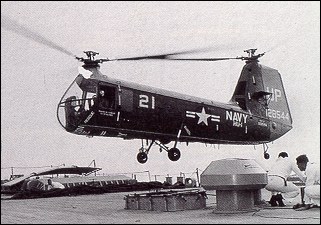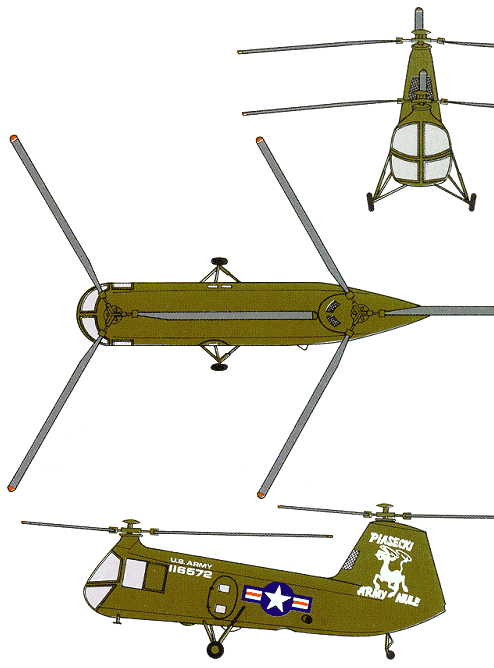
| Piasecki HUP "Retriever" 1985 |  |
 |

| Piasecki HUP "Retriever" 1985 |  |
 |
|
This tandem-rotor design was evolved by Piasecki Helicopter Corporation to meet a Bureau of Aeronautics requirement, issued in 1945, for a utility helicopter to be based aboard aircraft carriers and other large warships of the U.S. Navy for search and rescue, plane guard and general transportation duties. The proposed aircraft was given the works designation PV-14 and a prototype was completed for U.S. Navy evaluation as the XHJP-1. In 1948 work began on three pre-series HUP-1's, as the production version was known, and from 1950-52 a further twenty-two HUP-1 Retrievers were delivered to the U.S. Navy. They differed little from the original XHJP-1, the major apparent change being the addition of inward-sloping endplate fins to the horizontal stabilisers below the rear rotor head. Both sets of 3-blade rotors could be folded for shipboard stowage and the HUP-1, powered by a single 525hp Continental R-975-34 piston engine, could accommodate 4-5 passengers or 3 casualty litters in addition to the 2-man crew. Successful tests with a Sperry autopilot in the XHJP-1 enabled the next model, the HUP-2, to be built without tail surfaces and the more powerful Continental R-975-46 was installed in this and all subsequent production models. Another feature of the Retriever was a large rectangular rescue hatch offset to starboard in the floor of the front fuselage, through which a winch inside the cabin could lift weights of up to 181kg at a time. One hundred and ninety-three Naval HUP-2's were built; fifteen of these were supplied to France's Aeronavale, and the U.S. Navy machines included some completed as HUP-2S submarine-hunting aircraft with dunking sonar equipment. Another HUP-2 was given a sealed, watertight hull and outrigged twin floats for waterborne tests, presumably as part of the development programme for the Boeing-Vertol 107 / CH-46 helicopter. In 1951 the U.S. Army ordered a version of the HUP-2 with a reinforced cabin floor and hydraulically boosted controls, for general support and evacuation work. Seventy of these were delivered as H-25A Army Mule from 1953, as were fifty similar Naval HUP-3's (including three for the Royal Canadian Navy) for ambulance and light cargo duties. Production of the three hundred and thirty-ninth and last aircraft was completed in July 1954. Shortly after this a proposal was made to boost the speed, range and payload of all H-25/HUP aircraft still in service by refitting them with 700hp Wright R-1300-3 engines. However, this did not take place and by the time the new tri-service designation system was introduced in July 1962 only the HUP-2 and HUP-3 remained in service; these became the UH-25B and UH-25C respectively. Neither type is now in U.S. front-line service, and the French and Canadian HUP types were withdrawn from service in 1966. K.Munson "Helicopters And Other Rotorcraft Since 1907", 1968  After the first "flying banana", Piasecki immediately set to work on a specification, issued by the US Navy Bureau of Aeronautics in 1945, for a shipboard helicopter to be used on aircraft carriers and larger vessels for SAR, liaison, replenishment and plane guard duties. The result was the PV-14 (designated XHJP-1 by the US Navy). Three pre-production aircraft, the HUP-1, were ordered in 1948; this was followed between 1950 and 1952 by a full production batch using the 525hp Continental R-975-34 radial engine, which could carry two crew plus four-five passengers or three stretcher cases. The power-plant was installed at the center of the fuselage, which had a steel tube framework with particularly strong, fixed tricycle landing gear. The fin of the HUP-1 was subsequently eliminated, as further improved versions were fitted with an autopilot. The US Navy versions had all-weather instrumentation and some were equipped with sonar for antisubmarine warfare. The HUP-1 kept the classic, tandem rotor configuration, but had a smaller, more compact fuselage than its predecessors. This enabled the helicopter to be stowed without having to fold back the rotor blades. Once acceptance trials were over, the US Navy ordered 32 aircraft, followed by another 165 of the HUP-2, which was fitted with a more powerful engine. The Marines also used 13, while the Army acquired 70, designated H-25A, 50 of which were later transferred to the Navy as HUP-3s. Finally, 15 HUP-2s were built for the French Navy and three for the Canadian Navy. All these helicopters were withdrawn in 1956, but in the period from 1950-53, they received their "baptism of fire" in Korea, where they performed intensive transport, liaison and rescue missions, both on land and at sea. At the height of their career, they were in fact carried aboard all the aircraft carriers of the American fleet for rescue operations. G.Apostolo "The Illustrated Encyclopedia of Helicopters", 1984
Originally designed to meet a U.S. Navy requirement for a shipboard utility helicopter, the Piasecki Model PV-18 first flew in 1948 and entered regular Navy service the following year as the HUP-1 Retriever. In 1950 the Army, in the process of rapidly enlarging its helicopter fleet, evaluated several examples of the improved HUP-2 variant and judged the type suitable for use in the general utility role. A total of seventy H-25A aircraft (serials 51-16572 to -16641) were subsequently procured through an Air Force-managed contract, with the first of these entering regular Army service in early 1953. The Army Mule, as the H-25 was officially named, was a single engined, tandem rotor aircraft of fairly conventional design. The type was basically similar in general layout to the HUP-2, sharing that aircraft's all-metal fuselage, fixed three-point landing gear, and 550hp Continental R-975-42 engine. The H-25A differed from the Navy variant primarily in having hydraulically-boosted controls, a strengthened floor with cargo tie-down fittings, and modified doors intended to ease the loading and unloading of stretchers. Though a rugged and fairly capable aircraft the H-25A ultimately proved unsuited to the rigors of front-line Army service, and fifty of the seventy examples procured were turned over to the Navy beginning in 1955. Those Army Mules that remained in Army service were used mainly as training or medical evacuation aircraft, and the type was totally withdrawn from Army service by 1958. S.Harding "U.S.Army Aircraft since 1947", 1990
The 'flying banana' shape of the HRP-1 was discarded in the Piasecki Model PV-14, of which two XHJP-1 prototypes were ordered for evaluation in the rescue and aircraft-carrier plane-guard roles. This model was developed into the PV-18, US Navy designation HUP-1, which featured angled endplate fins on the horizontal tail surfaces mounted on the rear rotor pylon. Some 32 HUP-1s, each powered by a single 391kW Continental R-975-34 engjne, were built for the US Navy between February 1949 and 1952; the first squadron, HU-2, took delivery of its initial aircraft in February 1951. Successful Sperry autopilot trials in an XHJP-1 led to development of the HUP-2, whose improved directional ability allowed the endplate fins to be deleted, and the more powerful 410kW R-975-46 engine was fitted. A total of 339 was built, including 193 for the US Navy. A number of these were designated HUP-2S when fitted with dunking sonar equipment for anti-submarine operations. Some 15 HUP-2s were also supplied to the French navy. The US Army ordered an initial batch of an improved version in 1951, this being known as the H-25A Army Mule. Powered by the R-975-46A engine, the H-25A introduced power-boosted controls, strengthened floors and enlarged cargo doors. Fifty similar machines were transferred to the US Navy under the designation HUP-3, three serving with the Royal Canadian Navy's Squadron VH-21. Underthe unified designation system introduced in September 1962, the HUP-2 and HUP-3 were redesignated UH-25B and UH-25C respectively. D.Donald "The Complete Encyclopedia of World Aircraft", 1997
- The Piasecki Aircraft Corp. of Morton, Pennsylvania, evolved into today's Boeing Helicopter Company. - The first US Navy HUPs were delivered to squadron HU-2 in February 1951. - A Retriever could hover at 15m and lift an airman weighing 75kg. - After being transferred to reserve units, some HUPs were retained as rescue aircraft with an orange colour scheme. - PV-18 production totalled 339, including 70 H-25s for the US Army. - The Army's H-25s were procured by the USAF on the Army's behalf.
|